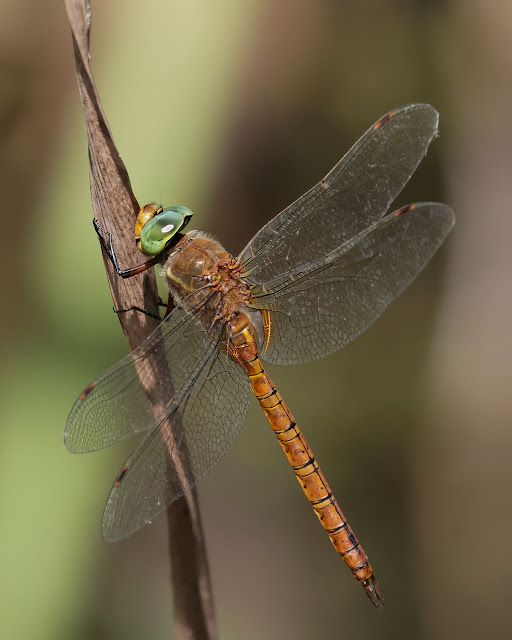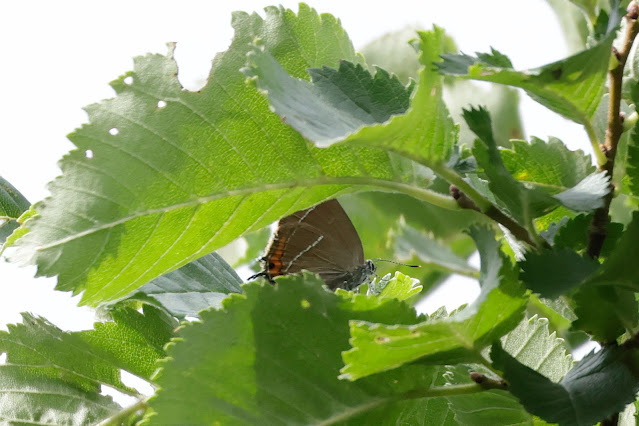Another blistering hot day forecast and it was very warm as I left home, but pulling up on the sea wall at Hill Head there was a lovely easterly breeze coming off the sea and cooling things down considerably. ut at sea Common Terns were fishing in the shallow waters of the low tide and from the reserve there was the unmistakeable sounds of the south scrape.
Ian arrived and we walked around to the visitor centre to book in. In the bay, with the tide low there were five redshank feeding on the mud, probably early returning birds, the summer doesn't last long for waders.
After checking in we checked out the Broad-leaved Helleborine, fenced off just inside the east side gate. It was still to flower but looked a little more advanced than the one seen in Abbotts Wood a week ago.
We walked around to the west side, as we approached the gate there were several white butterflies about and then once inside the gate, I picked up a Clouded Yellow butterfly cruising around the grass and flowers. We watched as it teased us, touching the grasses and flower heads as if to settle, this meant we had to follow but things looked positive and eventually it settled on the path.
But it didn't stay settled, moving on and leading us a dance once again, but this time it settled on an unopened flower head and stayed this time.
A migratory species here in the UK, we have good years when there are lots of them seen through the summer, and other years, like last year when they are hardly seen at all. This is my second sighting of the year, so I expect that this is a good year, and to get one settled like this is extremely unusual, normally you have to chase after them as they speed past, only to get a brief view as they lay in the grass.
Just inside the gate one of the many whites had settled on a daisy head. This one the larger Large White.
We were here for the recently reported Norfolk Hawker, a rare dragonfly here in the south, but we decided to drop into the Meon Shore Hide. The first thing to strike us was the water levels, despite the lack of rain they were very high with hardly any mud, much higher than they were a month agon when I was last here.
The Avocet were in a group at the far side of the scrape. Black-headed Gull juveniles were begging for food from the islands and amongst them were a few Common Tern. Colour was added by five Black-tailed Godwits that flew in.
A female Marsh Harrier patrolled the reeds at the back of the scrape and put up all the gulls and duck. In the distance a Buzzard circled high above the distantreed bed.
We decided to walk on to Darter's Dip. Butterflies were everywhere, mostly the three whites but also Speckled Wood, Red Admiral and Peacocks. Once again there was a LArge White posing nicely as it nectared on the bramble flowers
Another nice close up.
At the bridge there were several Common Blue Damselflies and this female Four-spot Chaser.
Ian started the search for the Norfolk Hawker, I wondered off and found this dragonfly. At frst I thought it was another Four-spot Chaser, but when I got home I looked in more detail. The eyes are blue, which was unusual. Looking very worn there was also black tips to the wings and at the base of the wings. I circulated the photo and asked for comments and the main opinion was that this was a Scarce Chaser, another rare dragonfly for the south coast.
Then Ian found the Norfolk Hawker and after a wait as it circled the pool, it finally it settled on a reed stem. A very distinctive dragonfly from the others seen at the dip. A rusty brown with distinctive green eyes. It is larger than the chasers and darters usually seen.
Here you can see the yellow markings on the thorax, indicating that this is a male.
They were found mainly in the ditches around the grazing marshes of the fens and broads in Norfolk, but recently have expanded moving through Kent and Cambridgeshire. They like clear water with at least 70% cover of Water Soldier, an invasive oxygenating plant. Recent records have found that outside of the Broads include ponds that are more like their sites in mainland Europe where it is less dependent on the Water Soldier.
Great to see this species here in Hampshire, a first for me. It looks like there are at least two today and there was also a report of a pair mating a few days ago.
The fourth dragonfly seen on the dip was this female Common Darter.
Unfortunately the search for the other rarity here, the Willow Emerald was unsuccessful. After a brief look in the Pumfrett Hide we walked down to the Spurgin Hide, which was as equally quiet. A walk back along the path towards the sea wall produced this nice Red Admiral.
We decided to try the Walkway pond on the east side for Willow Emerald, but without any luck. Plenty of bramble here and with it plenty more butterflies. A nice back lit Comma.
The Willows on both sides of the reserve were looking burnt with brown leaves, making the area look like autumn.
We speculated on what might have caused this, could it be stress brought on by the drought conditions. Well it turns out this was due to the larvae and adult forms of the Blue Willow Beetle. Despite the name it can be shiny green or even black.
It can become a severe pest, as is the case here. This has been bought on by the milder winters allowing the larvae to survive when normally controlled. The devastation occurs in the early summer months, but the trees will respond back with new leaves later in the year, some could already be seen sprouting.
We walked down to the Knight's Bank hide where there were more Comma and a few Marbled Whites. Both Black-headed and Mediterranean Gulls patrolled the meadow hawking insects coming up from the grass.
Coming out of the hide there was a confiding Green-veined White on the bramble, the second brood have a much more defined dark vein in the wings than those seen on the early broods in the year.
So an interesting day, with potentially two new dragonfly species, the Scarce Chaser and the Norfolk Hawker. Whilst I like the warm dry weather this has been very hot so I am looking forward to the break in the weather that should come mid week with things getting fresher.


















_MG_3095.jpg)






































